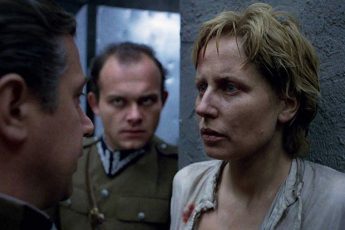Newborn-Porn and the Wannabe-Art Film of the Future
Srđan Spasojević’s A Serbian Film (Srpski Film, 2010)
Vol. 78 (October 2017) by Anna Batori
Self-mutation, necrophilia, incest, rape, violence, torture and, above all, hardcore pornography – Srđan Spasojević’s transgressive production merges all the possible taboos and most disgusting topics to shock the well-experienced spectator. A Serbian Film features brutal, visceral images and extreme graphic representation, which not only annihilates any kind of visual pleasure and/or identification with the characters, but raises the very concern about the distinction between art on the one hand, and art for art’s sake on the other. Where is the thin blue line that separates sex, nudity and their symbolic quality on screen from pure pornography? What subversive visual representation reaches and goes beyond the social and moral tolerance levels of the audience? And above all, what is the intent of films like A Serbian Film?
The pseudo-plot of Spasojević’s pseudo-film centers around the retired, middle-aged, alcoholic porn star Miloš (Srđan Todorović), who gets an unrefusable offer from “artist” and director Vukmir (Sergej Trifunović) to make his comeback as a porn star. Although the whole project is wrapped in mystery, his desperate financial situation and need to support his six-year-old son Petar (Luka Mijatović) and hot wife Marija (Jelena Gavrilović), drives Miloš into signing the puzzling contract. Soon the porn star finds himself swept into a non-conventional shooting featuring children, an abused woman, a homosexual guard and rivers of blood and semen.
The more the story progresses, the less Spasojević’s aims to create a narrative, which eventually turns the film into pure gore-pornography, with Miloš constantly having an erection, and performing sickening actions that raise the shock value of the film beyond endurance. In one of the scenes for instance, the porn star decapitates his sexual partner, while still having intercourse with the corpse of the beheaded woman. In another stomach-turning episode, Miloš watches a film that features the rape of an infant – a point when it is strongly advisable to rush headlong towards the exit of cinema. In case the brave (?) spectator decides to stay, he will have to witness the probably most repulsive scene of A Serbian Film where, before organising a massacre and killing the crew, the heavily drugged Miloš rapes his already brutally beaten-up wife and unconscious son.
Understanding Spasojević’s insatiable thirst for shock, these visual hyperboles become rather predictable after a while and because of this, less surprising for the spectator. After the sexual abuse of the new-born baby, it is only the rape of Miloš’s own child that could outstrip the shock tactics of the film – and make the spectator want to be re-born in another universe with no eccentric Spasojević-like people around. After all, A Serbian Film is driven by the single aim of provoking the viewer and to this end, it knows no thematic or aesthetic bounds. This self-securing gesture risks the artistic merit of the film for Spasojević turns his production into a weird mixture of disgust built on the exploitation of all the shocking codes of other genres. A Serbian Film is thus the fusion of sexploitation, hard-core porn, horror, and melodrama which, because of the eccentric employment of genre-specific tools and the audio-visual and thematic excesses that accompany it, turns the production into a kitschy, garish parody. This is one of the many reasons why A Serbian Film must not be compared with other sexually explicit, extreme films or feel-bad movies that have been proliferating the global arthouse scene. But how do we define the main difference between the films of Michael Haneke (The Piano Teacher, 2001), Takashi Miike (Ichi the killer, 2001), Bruno Dumont (Twentynine Palms, 2007), Catherine Breillat (Fat Girl, 2001), or Lars von Trier (Antichrist, 2009; Nymphomaniac I-II, 2013) – just to mention some of the most controversial directors of our time – and Spasojević’s production?
First of all, in contrast to extreme art cinema, A Serbian Film lacks any kind of authentic aesthetic approach. Or, to put it in another way, it exploits the art cinema style to such an extent that art itself disappears behind the director’s very eccentric purpose to outrage the audience. Spasojević uses an intermedial-intertextual frame for his film, with cameras following Miloš through his transformation into an “artist of fuck” – as Vukmir says. This already doubled emphasis on spectatorship gets even more stressed by projecting the subjective shots of the hand-held cameras that record the porn movie from various angles. In this way, there are several points of view that eventually melt together in the visual text, which causes serious obstacles in the flow of narrative and spectatorship. After a while, it is not clear whose perspective we see the events from, and more disturbingly, Spasojević constantly changes the brightness, saturation, and white balance of the subjective images, which results in a blurred, overexposed vision. The expressive zooming, the constantly shaking camera, the close-ups and the fuzzed memory scenes of the porn star about the shooting lead to a tsunami of visual stimulus, which eventually eradicates the continuity of physical space and action. What remains is a voyeuristic, pseudo-artistic approach to hard-core, horror-porn.
The excess of artistic audio-visual tools is, beyond doubt, the result of a very deliberate directorial decision. It is obvious that Spasojević does not take his film serious. Rather, the exploitative nature and whole concept of A Serbian Film is a test of the very boundaries of cinema. Again, whereas in Haneke, Brillet or Trier every sexually explicit scene is used to back up the story and create a strong psychological dimension that promotes narrative progression, the aim of Spasojević’s is exactly the opposite. With his main purpose being to drive the audience into sickening disgust, he sacrifices the story on the altar of subversive imagery. It would be thus be very offensive to call A Serbian Film art cinema, and blasphemous to put it in the same box with the films of Michael Haneke, Gaspar Noé or Kim Je-woon.
The subversive nature of the film, on the other hand, could be an attempt to continue the aesthetic tradition of the Yugoslav Black Wave and the sexually explicit cinema of Dusan Makavejev. In this case, A Serbian Film could be taken to use pornography as key to delivering a strong anti-establishment message. Although the use of physical extremes could be a perfect medium for such a critique of the socio-political order, in contrast to Makavejev, Spasojević fails to use eroticism as an allegorical device. Makavejev gave his sexually explicit images a revisionist, Freudo-Marxist tone that were combined by reflexive montage-sequences. The juxtaposition of Stalin and a frozen phallus in WR: Mysteries of the Organism (WR: Misterije organizma, 1971) or the occurring penis captivus of the Latin Singer and Miss Canada in Sweet Movie that happens on the Eiffel Tower surrounded by sightseeing nuns, are all part of a very strong allegorical construction that originates from a totalitarian ideology – be that capitalism or Stalinist communism. Although, as the title indicates, A Serbian Film wants to fulfill a similar task, the director’s sequences do not manifest any resemblance with present-day Serbia.
Spasojević himself argued that A Serbian Film is a family drama that turns into hell (Klapka, 2014), while he also stated that his production is an allegory of Serbian national cinema1; the European film order2; the post-Yugoslav disintegration3; as well as contemporary Serbian politics4. It seems that Spasojević wanted to create a multi-layered allegory of Europe’s socio-historical history and, while trying to achieve this impossible task, got lost in the endless labyrinth of metaphoric texts. Unfortunately, as demonstrated above, Spasojević himself is confused about what his own film is about and, while giving controversial statements what A Serbian Film signifies, he blames the audience for not understanding his masterpiece: “They don’t understand even the basic things from the film: you have a good guy and bad guys; the bad guys are doing bad things and the good guy is fighting against them. They don’t understand because the movie language that we use in the film is actually closer to that of Western films than to our own” (Sélavy, 2010).
Of course, accusing the spectator and criticizing his taste is always easier than facing the fact that the production has no deeper layer. More troubling is the fact that critics are informed by the frame of European art film and anti-Hollywood cinema to such an extent, that they desperately praise every film that features a long shot and/or a depressed protagonist in the leading role. This is how imbecile cinema gets boxed as art, as illustrated by Lanthier:
‘A Serbian Film shouldn’t be mistaken for absurdism. We’re most intimidated not by the imagery itself, but by the hazy, primitive sector of our brains that the movie shocks out of torpidity. Spasojević knows man’s ultimate dirty secret: We are all born into—and out of—histories of tasteless perversion that we silence as we begin to consider the needs of others as well as our own. (…) The dreamy realm in which human desire, memory, and fantasy collide and intermingle is a wickedly necessary one; it encompasses the urges and peculiarities that not only perpetuate mankind as a species, but incubate individual personality. And A Serbian Film understands that this area of the mind is where we are at our most impressionable and vulnerable’5.
Unfortunately, this overwrought explanation was picked up by film festivals, retailers and critics as well. The film’s Australian distributor claimed that, “A Serbian Film is for adults. If you cannot understand what the film is saying and means, you are not an adult and the film is not for you.” This rather offensive statement takes us for idiots, who cannot de-code the over-sophisticated language of the film. The fact that there is even a small percentage of critics that praise the film shows the snobbery of the European art scene, and demonstrates the great crisis of art cinema and academic scholarship we are in.
Again, whereas Haneke, Trier or Seidl aestheticize sexuality – even if in a transgressive form – Spasojević mistakes it for hard-core porn, and destroys a family on screen by using the latter as the main cause for the Serbian post-war social apocalypse. In the role of Vukmir – his pseudo-artistic alter-ego – he proclaims that Serbia and art are both dead, while the rape of a new-born baby – which he calls new-born porn – projects the image of a victimized nation. When Miloš poses the very reasonable question what pornography has to do with all this – the only smart sentence that comes out of his mouth during the film -, Vukmir comes up with the explanation that rape is not pornography, but life itself. This metaphor, together with the gothic gore-like massacre scene in the end, could thus symbolize the Balkan war and its aftermath. However, the main emphasis on the brutal pornographic context, and the badly structured, hollow narrative of the film simply do not provide the means for drawing such a parallel. Even more so, because Vukmir and the director himself dispassionately admit that their artistic concepts are to exploit and make money out the story of the victim, “the priciest sell in the world”.
The question of authenticity comes up every time the characters make an appearance. For instance, in his role as porn legend with “the most special cock”, paunchy Miloš appears rather ridiculous. Anyone who has ever seen porn knows that the most important component of the genre are the looks of the characters, which refers to well-trained, six-packed, tanned bodies and, of course, decent sizes. Although A Serbian Film pays special attention to the latter – especially when it comes to the hilariously over-eroticized female characters; Miloš seems rather fake in the midst of the porn-tribe. Be that the actual film, the sex scenes they are shooting, or the man’s older productions that he likes to re-watch so much, his physiognomy is that of a burnt-out, average man that make it impossible to believe that he has anything to do with porn.
It is not only his physical appearance that makes the spectator unsure of the man’s ex-occupation, but his demolished masculine position in the narrative as well. Miloš is only brimmed with testosterone when it comes to sexual intercourse. Other than that, he behaves like a floppy, lost and depressed anti-man. In a terribly sexist episode for example, his wife invites him to play hard-core porn in bed which Miloš responds to by raping her. Apart from the very disturbing fact that this act is portrayed as enjoyable for the woman – which also tells a lot about Spasojević himself – this is the only episode where Miloš practices agency. This scene aside, he usually escapes into alcohol or, if not busy playing with his “special cock”, he stands around with his empty, senseless eyes. Miloš is thus everything but the bull of the town, which challenges the very premise of the story.
The shallow, illogical character-descriptions and the shock tactics signal that Spasojević only wanted to make a (bad) joke with A Serbian Film. This is best illustrated by the scene of Miloš getting ready for the shooting. In a cross-cut, we see him in a Rocky-like sequence running in the woods, practicing yoga and meditation, while in a parallel one, we follow his brother’s masturbation in their family bathroom. In the whole parallel sequence, Miloš looks more like a ludicrous fellow. In a similar vein, the masturbation of his brother bears an ironic undertone, especially given that Spasojević embeds it in the parallel montage of the ejaculation of Marko and of Miloš finding inner peace under a tree. This cross-cut not only makes a laughing stock of the warming-up scenes of action movies, but eradicates the last sprout of sense of reality in the film. What is born this way is an extended ridicule beneath the trashiest trash of all times – exactly the thing that Spasojević wanted to achieve.
Ironically, A Serbian Film puts Serbia back into the folklorist-exoticizing box of self-Balkanization, thus mediating stereotyped and false images of the region – a phenomenon that has been widely discussed by scholars after the premiere of Emir Kusturica’s Underground (1995). Similarly to Kusturica, Spasojević forces the Balkan to have the position of the ‘Other’ which, as Žižek6 and Jameson7 point out, accentuates the gap between the region and the West. With its eccentric porn-plot, A Serbian Film moves forward in distancing the West from the Balkans by putting emphasis on violence and extreme masculine power (while avoiding any kind of bitter irony and humor that make Kusturica’s cinema so outstanding). Using the very disfigured image of one of the most visceral features of humankind for the purpose of emphasizing the outsider position of Serbia as ‘Other’, is certainly not the smartest way to go. It creates a false vision of the nation and, by emptying the plot to the level of hard-core porn, describes the Balkans as the home of sexists and empty-headed beasts. But maybe this is exactly what Spasojević wanted to achieve.




Leave a Comment